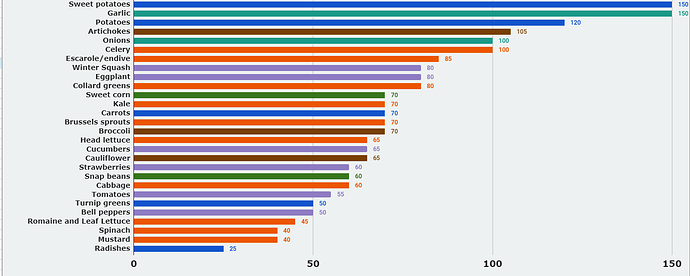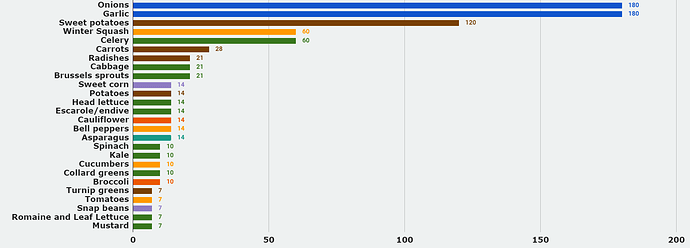@regina.smart haha, definitely not!
I’m assuming here that the goal is to answer the question “which fruits and vegetables that are available in a grocery store now could be potentially grown in a CEA (hydroponics & LEDs) farm within the next 10 years?” - these are all produced at scale and not just popular with home gardeners. I can have a totally different response - all about herbs - if we’re not as focused on the industry.
**The first way to help students select a plant for growing I’d look at is how long a plant takes to harvest.**The chart below shows harvest durations of common crops that could feasibly be grown in a MARSfarm product. This is filtered to only be fruit/vegetable commodity crops that are large enough in scale ($$$) to justify technology investment by the agriculture industry - meaning no herbs. Any of the Orange, Brown, or Purple plants could be grown in your equipment.
- Orange bars = Leaves at beginning of vegetative phase.
- Blue bars = Roots at the end of the vegetative phase.
- Brown bars = Buds/Flowers at the beginning of the reproductive phase.
- Green bars = Pods/Seeds at the end of the reproductive phase.
- Purple bars = Fruits at the end of the reproductive phase.
Chart of days til harvest, colors indicate the anatomical part of the plant that is commercially harvested.
The second thing to think about is which plants, if produced locally, would be more valuable to the market. In essence, CEA enables farmers to grow any plant, anywhere in the world. So because CEA farms cost more to operate (sunlight is free) the value being given to the existing market must come from somewhere else in the supply chain. Here are a few ideas:
- food waste in grocery stores (the spoiled product that is thrown out)
- cost of cold storage (on-farm and off-farm)
- cost of freight
Millions (in some cases billions!) of dollars are wasted by food retailers. This is only what they grow away at the store and doesn’t include the (much larger figure) of what is thrown away after it sits in your home refrigerator. A kale plant that is 1 day old has a significantly higher value than one that’s a week old - both immediately to the retailer and long-term to consumers as well. In contrast, a cabbage plant (very similar to grow) has a shelf life of 60 days - making the value of having “fresh cabbage” less than that of “fresh kale” or “fresh spinach”.
Chart of days before food spoilage, assuming cold storage conditions (40F)
| Fresh Vegetables | Average Shrink 2011-2012 | Uneaten Whole Fresh Vegetables | U.S. Retail Food Price | U.S. Retail Food Waste $ |
|---|---|---|---|---|
| Romaine and Leaf Lettuce | 20.2% | 681,000,000 | $ 2.75 | $ 1,872,750,000.00 |
| Head lettuce | 8.3% | 345,000,000 | $ 1.84 | $ 634,800,000.00 |
| Spinach | 18.2% | 78,000,000 | $ 3.83 | $ 298,740,000.00 |
| Tomatoes | 15.0% | 790,000,000 | $ 1.50 | $ 1,185,000,000.00 |
| Bell peppers | 11.0% | 361,130,000 | $ 1.72 | $ 621,143,600.00 |
| Strawberries | 14.2% | 322,000,000 | $ 4.21 | $ 1,355,620,000.00 |
Table of five examples of crops that I think can be profitably grown in a U.S. CEA facility.
Thirdly, we ask the question - what is the cost of growing this with CEA equipment? The most important variable is the quantity of light a plant requires on a given day. The second most important variable to growth is the hydroponic nutrient solution.
source: Day Light Integral - Top 5 CEA Plants - St. Louis Climate.xlsx - Google Sheets
Use the table below to find recommendations for the pH and quantity of nutrients to add.
I recommend that you start with Orange crops - which we eat the leaves of - these will do well in the Deep Water Culture hydroponic systems that came with your MARSfarm Mini Version 0.2 (V0.21 and V0.23) units.
| Plants | pH | cF | EC | PPM |
|---|---|---|---|---|
| Ambra radicchio | 5.5-6.5 | |||
| Artichoke | 6.5-7.5 | 8-18 | 0.8-1.8 | 560-1260 |
| Asparagus | 6.0-6.8 | 14-18 | 1.4-1.8 | 980-1260 |
| Bean (Common) | 6.0 | 20-40 | 2-4 | 1400-2800 |
| Beans (Italian bush) | 6.0-6.5 | |||
| Beans (Lima) | 6.0-6.5 | |||
| Beans (Pole) | 6.0-6.5 | |||
| Beetroot | 6.0-6.5 | 8-50 | 0.8-5 | 1260-3500 |
| Broad Bean | 6.0-6.5 | 18-22 | 1.8-2.2 | 1260-1540 |
| Broccoli | 6.0-6.5 | 28-35 | 2.8-3.5 | 1960-2450 |
| Brussell Sprout | 6.5-7.5 | 25-30 | 2.5-3.0 | 1750-2100 |
| Cabbage | 6.5-7.0 | 25-30 | 2.5-3.0 | 1750-2100 |
| Capsicum | 6.0-6.5 | 18-22 | 1.8-2.2 | 1260-1540 |
| Carrots | 6.3 | 16-20 | 1.6-2.0 | 1120-1400 |
| Cauliflower | 6.0-7.0 | 5-20 | 0.5-2.0 | 1050-1400 |
| Celery | 6.5 | 18-24 | 1.8- 2.4 | 1260-1680 |
| Collard greens | 6.5-7.5 | |||
| Cucumber | 5.8-6.0 | 17-25 | 1.7-2.5 | 1190-1750 |
| Eggplant | 5.5-6.5 | 25-35 | 2.5-3.5 | 1750-2450 |
| Endive | 5.5 | 20-24 | 2.0-2.4 | 1400-1680 |
| Fodder | 6.0 | 18-20 | 1.8-2.0 | 1260-1400 |
| Garlic | 6.0 | 14-18 | 1.4-1.8 | 980-1260 |
| Leek | 6.5-7.0 | 14-18 | 1.4-1.8 | 980-1260 |
| Lettuce | 5.5-6.5 | 8-12 | 0.8-1.2 | 560-840 |
| Marrow | 6.0 | 18-24 | 1.8-2.4 | 1260-1680 |
| Okra | 6.5 | 20-24 | 2.0-2.4 | 1400-1680 |
| Onions | 6.0-6.7 | 14-18 | 1.4-1.8 | 980-1260 |
| Pak-choi | 7.0 | 15-20 | 1.5-2.0 | 1050-1400 |
| Parsnip | 6.0 | 14-18 | 1.4-1.8 | 980-1260 |
| Pea | 6.0-7.0 | 8-18 | 0.8-1.8 | 980-1260 |
| Peas (Sugar) | 6.0-6.8 | |||
| Pepino | 6.0-6.5 | 20-50 | 2.0-5.0 | 1400-3500 |
| Peppers | 5.8-6.3 | 20-30 | 2.0-3.0 | 1400-2100 |
| Bell peppers | 6.0-6.5 | 20-25 | 2.0-2.5 | 1400-1750 |
| Hot Peppers | 6.0-6.5 | 30-35 | 3.0-3.5 | 2100-2450 |
| Potato | 5.0-6.0 | 20-25 | 2.0-2.5 | 1400-1750 |
| Pumpkin | 5.5-7.5 | 18-24 | 1.8-2.4 | 1260-1680 |
| Radish | 6.0-7.0 | 16-22 | 1.6-2.2 | 840-1540 |
| Spinach | 5.5-6.6 | 18-23 | 1.8-2.3 | 1260-1610 |
| Silverbeet | 6.0-7.0 | 18-23 | 1.8-2.3 | 1260-1610 |
| Sweet Corn | 6.0 | 16-24 | 1.6-2.4 | 840-1680 |
| Sweet Potato | 5.5-6.0 | 20-25 | 2.0-2.5 | 1400-1750 |
| Swiss chard | 6.0 6.5 | |||
| Squash (Summer) | 5.0-6.5 | |||
| Squash (Winter) | 5.0-6.5 | |||
| Taro | 5.0-5.5 | 25-30 | 2.5-3.0 | 1750-2100 |
| Tomato | 5.5-6.5 | 20-50 | 2.0-5.0 | 1400-3500 |
| Turnip | 6.0-6.5 | 18-24 | 1.8-2.4 | 1260-1680 |
| Zucchini | 6.0 | 18-24 | 1.8-2.4 | 1260-1680 |


